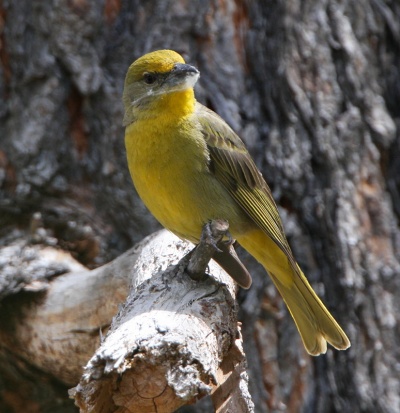
Photo by: Gary Clark
Location: Bandelier National Monument, New Mexico, USA.
- Piranga flava
Includes: Tooth-billed Tanager; Red Tanager
Identification
20cm (8").
- Male: dark red to orange-red, grey wash on back and flanks. Grey-red cheek patch. Heavy, slightly hooked, and dark bill.
- Female: olive-green upperparts and yellow-orange underparts with grey wash on flanks.
- Juvenile: paler underparts, brown streaks, and buff-gray wing-bars.
Variation: males of the Highland Hepatic Tanager group have a two-toned bill, dark upper and yellow lower mandible; in Lowland Hepatic Tanager, the lower mandible is grey vs black for upper. The three forms also differ in the tone of the red in males, as seen in the images.
Distribution
North America, Central America, and South America.
In the U.S.A, summers in Arizona and New Mexico. These and populations in northern Mexico mostly migrate south to an area from southern Mexico to Guatemala. Populations breeding in Guatemala and Belize and south through Central and South America are resident. In western and northern South America, they primarily are found in highlands of Trinidad, Venezuela, The Guianas, Colombia, Ecuador, Peru, and Bolivia. A separate form is found mainly in lowlands of They Guianas, Brazil, eastern Bolivia, Paraguay, north eastern Argentina and Uruguay.
Taxonomy

Location: Bandelier National Monument, New Mexico, USA.
Several subspecies exists. These fall into three main groups that sometimes are considered separate species: The Northern Hepatic Tanager (P. hepatica - first five subspecies in the list), the Highland Hepatic Tanager (P. lutea - subspecies 6-11 in the list) and the Lowland Hepatic Tanager (P. flava - last four subspecies):
- P.f. hepatica
- P.f. dextra
- P.f. figlina
- P.f. savannarum
- P.f. albifacies
- P.f. testacea
- P.f. desidiosa
- P.f. lutea
- P.f. haemalea
- P.f. faceta
- P.f. toddi
- P.f. macconnelli
- P.f. saira
- P.f. rosacea
- P.f. flava
Habitat
Open pine and pine-oak forests, often near water.
Behaviour
Diet includes insects, figs, ripe guavas, and other fruits.
Male of Lowland group showing paler red and also a two-toned bill
Photo by Rogerio Araújo Dias
Brasilia, Brazil
References
- Clements, JF. 2009. The Clements Checklist of Birds of the World. 6th ed., with updates to December 2009. Ithaca: Cornell Univ. Press. ISBN 978-0801445019.
- Ber van Perlo. 2009. A field guide to the Birds of Brazil. Oxford University Press, New York, NY, USA. ISBN 978-0-19-530155-7
- Kenefick, Restall, Hayes, 2007. Field guide to the birds of Trinidad and Tobago. Yale University Press. ISBN 978-0-300-13557-2
- Howell & Webb, 1995. A guide to the birds of Mexico and northern Central America. Oxford University Press. ISBN 0198540124





